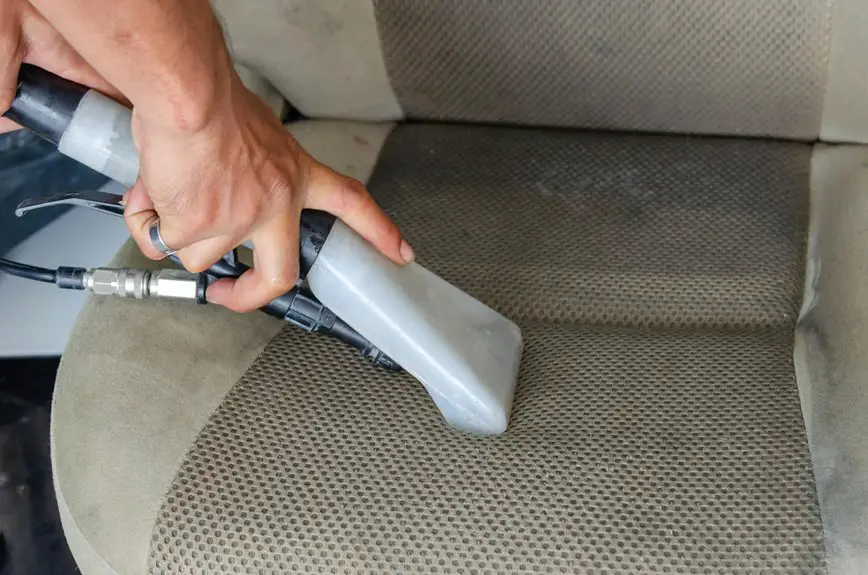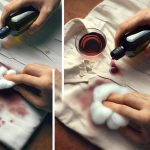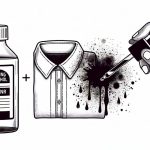To spot clean upholstery fast, start by checking the fabric type and care tag to pick the right cleaner. Test your solution on a hidden spot, then apply it gently to the stain with a clean cloth, blotting from the outside in. Use mild detergent for food stains or rubbing alcohol for ink. Afterward, blot with a damp cloth and dry. Acting quickly helps, and knowing these basics gets you started; there’s more to master for perfect results.
Table of Contents
Key Takeaways
- Identify stain type and check upholstery care tags before choosing a cleaning solution.
- Test any cleaner on a hidden area to avoid fabric damage or discoloration.
- Apply cleaner gently, blotting from the stain’s edge toward the center to prevent spreading.
- Use mild detergent for food stains, rubbing alcohol for ink, and water-based cleaners for coffee or tea.
- Dry the area thoroughly after cleaning and vacuum regularly to prevent dirt buildup and future stains.
Understanding Different Upholstery Fabrics
Before you plunge into spot cleaning, it’s important to understand the type of fabric your upholstery is made from. Different fabrics react differently to cleaning agents and methods, so knowing your fabric helps you avoid damage.
Natural fibers like cotton and linen absorb spills quickly but can stain easily. Synthetic fabrics such as polyester and nylon are generally more stain-resistant and easier to clean. Delicate materials like silk or velvet require extra care and specialized cleaners.
Check your furniture’s care tag for cleaning codes: “W” means water-based cleaners are safe; “S” indicates you should use solvent-based cleaners; “WS” allows either; and “X” means professional cleaning only.
Essential Supplies for Spot Cleaning
Gathering the right supplies makes spot cleaning your upholstery more effective and less stressful.
You’ll need a clean white cloth or sponge to avoid color transfer. Have a soft-bristled brush handy for gently loosening dirt. Keep a spray bottle filled with water or a mild upholstery cleaner nearby.
For tougher stains, a small bowl of mild detergent diluted in water works well. Avoid harsh chemicals unless specified for your fabric type.
Paper towels are great for blotting excess moisture without rubbing. Don’t forget gloves to protect your hands, especially if you use cleaning solutions.
Finally, keep a vacuum cleaner ready to remove loosened dirt after spot cleaning. With these essentials prepared, you’ll tackle stains quickly and confidently.
Step-by-Step Spot Cleaning Process
First, you’ll want to identify the type of stain to choose the right cleaning solution.
Next, apply the cleaner carefully to avoid damaging your upholstery.
Following these steps guarantees a more effective spot cleaning process.
Identify Stain Type
How do you know which cleaning method to use? First, you need to identify the type of stain you’re dealing with. Different stains require specific approaches to avoid damage and guarantee effective removal. Here’s a quick reference to help you categorize common stains:
| Stain Type | Description |
|---|---|
| Water-based | Coffee, tea, juice |
| Oil-based | Grease, makeup, salad dressing |
| Protein-based | Blood, sweat, dairy |
| Dye-based | Ink, wine, grass |
Apply Cleaning Solution
Begin by testing your chosen cleaning solution on an inconspicuous area of the upholstery to guarantee it won’t cause discoloration or damage.
Once you confirm it’s safe, apply a small amount of the solution directly onto the stain. Use a clean white cloth or sponge to gently blot the stain—avoid rubbing, which can spread it or damage fibers.
Work from the outside of the stain toward the center to prevent it from spreading. Let the solution sit for a few minutes to break down the stain, but don’t let it dry completely.
Afterward, blot the area with a damp cloth to lift the residue. Finally, use a dry towel to absorb excess moisture, allowing the spot to air dry fully before using the upholstery again.
Removing Common Stains Effectively
Before you tackle a stain, you need to identify what caused it.
This helps you pick the right cleaning solution that won’t damage your upholstery. Knowing the stain type makes your spot cleaning more effective and safer for your fabric.
Identifying Stain Types
When you spot a stain on your upholstery, the first step is to figure out what caused it. Different stains need different treatments, so identifying the stain type helps you act quickly and correctly.
Is it oily, like grease or makeup? Or water-based, such as juice or coffee? Protein stains, like blood or sweat, require a different approach than tannin stains from tea or wine.
You might also face dye stains from ink or markers, which can be stubborn. Look closely at the stain’s color, texture, and smell if needed. Knowing what you’re dealing with prevents damage and boosts your chances of removing it completely.
Don’t rush; taking a moment to identify the stain sets you up for success in your cleaning process.
Choosing Cleaning Solutions
Although selecting the right cleaning solution depends on the type of stain, using the appropriate product can make all the difference in removing it effectively. You want to match the cleaner to the stain for quick, thorough results without damaging your upholstery. Here’s a handy guide to help you choose:
| Stain Type | Recommended Cleaning Solution |
|---|---|
| Food & Beverage | Mild dish soap and warm water |
| Ink | Rubbing alcohol or hand sanitizer |
| Grease | Baking soda paste or dish soap |
| Pet Stains | Enzyme-based cleaner |
Always test a small, hidden area first to verify the solution won’t discolor or harm your fabric. Using the right cleaner saves time and keeps your upholstery looking fresh.
Tips for Preventing Future Stains
To keep your upholstery looking fresh, you’ll want to adopt habits that minimize the risk of stains. Start by establishing a no-food-or-drink rule near your furniture to avoid accidental spills.
Use slipcovers or washable throws in high-traffic areas for extra protection. Regularly vacuum your upholstery to remove dust and dirt that can embed and cause discoloration over time.
Quickly address any spills with a clean cloth to prevent them from setting. Consider applying a fabric protector spray designed for your upholstery type to repel liquids and stains.
Finally, rotate cushions and pillows frequently to guarantee even wear and minimize dirt buildup in one spot. These simple steps help you maintain your upholstery’s appearance and extend its lifespan.
When to Call a Professional Cleaner
If your upholstery has stubborn stains or delicate fabrics that resist home cleaning methods, calling a professional cleaner is your best bet.
Professionals have the right tools and expertise to handle tough stains without damaging your furniture. You should also consider a pro if your upholstery is vintage, made from silk, or other sensitive materials.
When stains cover a large area or have set deeply, DIY methods mightn’t be effective. Additionally, if you’re unsure about the cleaning products or techniques to use, it’s safer to let experts take over.
Hiring a professional saves time and prevents accidental damage, ensuring your upholstery looks fresh and clean without the risk of worsening the stain or fabric wear.
Don’t hesitate to seek help when needed.
Frequently Asked Questions
Can Upholstery Be Safely Cleaned With Natural or Homemade Solutions?
You can safely clean upholstery with natural solutions like vinegar and baking soda, but you should always test a small hidden area first. This helps avoid damage and guarantees the fabric reacts well to homemade cleaners.
How Often Should Upholstery Be Deep Cleaned Professionally?
You should get your upholstery professionally deep cleaned at least once a year. Studies show homes accumulate up to 40 pounds of dust annually, so regular cleaning keeps your furniture fresh and extends its life.
Are There Specific Spot Cleaning Techniques for Pet Hair Removal?
Yes, you can use a rubber glove or damp sponge to loosen pet hair, then vacuum it up. You’ll also find pet hair removal brushes or lint rollers super effective for quick, targeted cleaning.
What Are the Best Ways to Deodorize Upholstery After Cleaning?
Think of freshness as a gentle breeze lifting away stale memories. You can sprinkle baking soda, let it rest, then vacuum. Or use fabric sprays and essential oils to revive your upholstery’s spirit and comfort your senses.
How Do Humidity and Temperature Affect Upholstery Cleaning Results?
Humidity slows drying, making stains linger and causing mildew, while high temperatures speed drying but might set stains if too hot. You’ll want moderate conditions to clean effectively without damaging your upholstery.
- Repairing Scratches on a Leather Sofa: A DIY Guide - July 9, 2025
- How to Fix Cat Scratches on a Leather Sofa (and Prevent Them!) - July 9, 2025
- How to Stitch a Ripped Seam on a Leather Sofa - July 9, 2025






